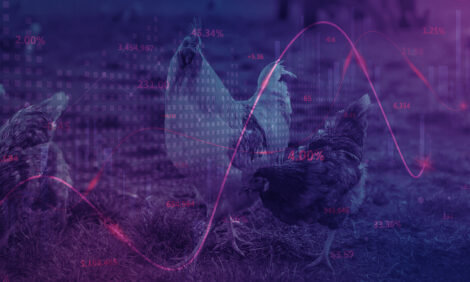



Poultry Outlook Report - December 2004
By U.S.D.A., Economic Research Service - This article is an extract from the December 2004: Livestock, Dairy and Poultry Outlook Report, highlighting Global Poultry Industry data. The report indicates that the increase in broiler production in 2005 is expected to slow to about 3 percent, down from the 4 percent increase expected this year.
Broiler exports have benefited over the last several months from the decline in U.S. prices of most broiler parts. The recent reopening of the Chinese market to U.S. poultry products is expected to strengthen exports of U.S. broiler parts. Broiler prices are expected to gradually strengthen from their current lows over the next several months as slower production increases and stronger exports draws down relatively high stocks.
U.S. Broiler Production Lowered
Estimated 2005 broiler production was decreased by 100 million pounds to 35.1
billion pounds, as recent egg sets have been running considerably lower than earlier
this year. The weekly broiler hatchery report continues to show increases in the
numbers of broiler chicks being placed for growout. However, over the last 5
weeks (Nov. 6 through Dec. 4), the number of broiler eggs being placed in
incubators has averaged 206.7 million per week, up less than 1 percent from the
same period in 2003. This data for egg sets indicate that chick placements, on a
year-over-year basis, can be expected to be considerably lower in the next several
weeks after averaging 3 to 4 percent higher for most of the last 5 months.
U.S. broiler production in fourth-quarter 2004 is estimated at 8.6 billion pounds, 4.4
percent higher than in fourth-quarter 2003. Broiler production in October was 2.9
billion pounds, down 5.2 percent from a year earlier, as October 2004 had two less
slaughter days than in October 2003. The loss of a slaughter day normally means
close to a 5-percent drop in monthly production. November has two additional
slaughter days compared with the previous year and should result in a double-digit
increase in production. This follows a third-quarter where production increased 4.6
percent compared with a year earlier. The increase in production is expected to
come from both higher numbers of birds going to slaughter and continued growth in
their average weights.
Broiler Stocks Move Upward
As year-over-year growth in production has risen in 2004, stocks of broiler products
held in cold storage have started to accumulate. The estimate of cold storage
holdings of broiler products at the end of October was 796 million pounds, up 33
percent from a year earlier. Over the first 5 months of 2004 stock levels were
below the previous year, but starting in June stocks have increased by over 40
million pounds.
With increases in production and growing amounts of product in cold storage,
domestic broiler prices have declined. The November 12-city average for whole
broilers was 68.1 cents a pound. This was still up 6 percent from the previous year,
but prices have fallen around 14 cents a pound from where they were in June. Leg
quarter prices were 30 cents per pound in November, slightly higher than the
previous year, but leg quarter prices also have fallen since June (down 7 cents a
pound). Broiler prices are expected to gradually strengthen over the next several
months as lower production and stronger exports should result in stock reductions.
U.S. broiler exports in October 2004 were a record 568 million pounds, slightly less
than 5 million pounds above the previous record set last October. This leaves
exports for the first 10 months of the year at 3.85 billion pounds, still 6 percent
lower than the same period in 2003. The quantity of broiler exports has benefited
over the last several months from the decline in prices for most broiler parts.
Shipments are also expected to strengthen over the next several months with the
reopening of the Chinese market to U.S. poultry products.
Turkey Production Down, Prices Higher
In November, the price for whole turkeys (hens) in the Eastern region averaged 78.3
cents per pound, up 13 percent from the previous year. Wholesale prices for whole
birds and parts are expected to decline slightly on a seasonal basis during the next
several months, but prices for most turkey products are expected to be supported by
the current low levels of cold storage stocks of turkeys (whole birds and parts). At
the end of October, stocks of whole birds were 260 million pounds, down 21
percent from the previous year, and stocks of turkey parts were 230 million, 10
percent lower than last year.
Turkey production during the first 10 months of 2004 has totaled 4.5 billion pounds,
down 4.9 percent from the same period in 2003. The decline in production has been
the result of a smaller number of birds being slaughtered, as the average weight of
birds has been slightly higher so far in 2004. Production over the next several
months is expected to remain below the previous year. Over the last 6 months,
(May through October), the number of poults placed for growout has only totaled
138 million birds, 4.7 percent lower than the same period in 2003.
U.S. turkey exports, after showing a 3.9-percent increase in the third quarter to 134
million pounds, fell somewhat in October to 43.3 million pounds, down 14 percent
from the previous year. However, exports to Mexico continue to be strong.
Shipments to Mexico were 26.8 million pounds in October boosting exports over
the first 10 months of 2004 to 211 million pounds, 9 percent higher than the
previous year.
Turkey exports in general, and exports to Mexico specifically may
be pressured in the coming months by strong U.S. prices and the institution of an
inspection fee by the Mexican Government. Prices for whole turkeys have shown
double-digit gains compared with the previous year and prices are also higher for
other turkey parts. The Mexican Government has announced the institution of
inspection fees to help offset the cost of border inspections. The fees are expected
to amount to approximately $450 per truck. This fee structure would more heavily
impact items with a lower unit value, such as mechanically deboned turkey meat to
be used in the Mexican food processing industry.
Links
For more information view the full Livestock, Dairy and Poultry Outlook - December 2004 (pdf)Source: Livestock, Dairy and Poultry Outlook - U.S. Department of Agriculture, Economic Research Service - December 2004








